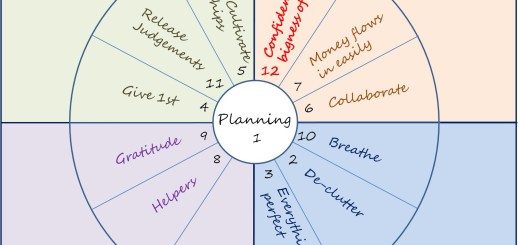Realistic Goals
 Some experts advise that to make your goals become reality you should use the SMART system. In fact, my colleague and I talk about it in one our instructional programs.
Some experts advise that to make your goals become reality you should use the SMART system. In fact, my colleague and I talk about it in one our instructional programs.
SMART is an acronym for Specific, Measurable, Attainable, Realistic (or Relevant) and Timely.
After a lot of trial and error, I’ve come to realize what I do to achieve goals is even more basic because all of the parts of the acronym are merely different aspects of the same thing. For me, it all boils down to the “R” in SMART… Is the goal Realistic, and how can I make it Real?
Here’s what I do with a goal to make it real:
1. I write it down.
Writing down a goal makes it real rather than it being just something in my imagination. Did you know that only 2% of Americans ever write down their goals? That means the vast majority of Americans walk around with dreams in their heads but really don’t have goals. I say that because, frankly, if a wish or a dream stays in your head, that’s all it will ever be… a wish or a dream. However, a dream becomes a goal when you write it down, make a plan to achieve it and then execute the plan.
2. I break it down.
I figure out necessary resources, do calculations and determine possible timelines/due dates. For example, doing calculations regarding a financial goal is imperative. Otherwise how else will you gauge your chances for success? Equally important is setting timelines/due dates. They get you motivated to begin, give you a sense of urgency to keep going and help you monitor your progress toward reaching the goal. Anyway, as I’m breaking my goal down, I’m constantly asking myself, “Is this realistic?”
3. I build a plan.
No, I’m not Russian, but I do think that every goal needs a plan of execution or else it just remains an idea. The plain truth is that if it doesn’t go on my calendar, it doesn’t get done. Keep in mind though, that it’s not just your goal that needs to be realistic, your plan must be realistic too. If it’s not realistic, it will cause you a lot of stress. For instance, think about what will happen if you don’t reach the goal by the deadline. Do you need to build in a buffer of time? If possible, allow yourself the ability to re-set your timelines as you go along.
A personal example…
When nearing the completion of my latest book (which I intend to publish in February 2014), I decided to set a goal to write every day. I got out a notebook and broke it down using a calculator and a calendar. What kind of schedule could I keep and how many hours on certain days could I write? Ultimately, I wanted to see how many hours of writing I could accomplish during a certain 48-day period. It came out to 80 hours of writing time, which I realized was pretty ambitious. Nevertheless, I blocked the time on my calendar. Since I know that I’m not THAT disciplined and because I know my schedule requires a lot of flexibility to accommodate unexpected projects that might trump my book writing time, I made a deal with myself to not stress too much if I didn’t make it by exactly 48 days. The good news is that I stuck reasonably close to the schedule, and I did reach my goal of finishing the first draft within the 48-day deadline.
__________________________________________________________
Angela Loëb helps people rediscover and use their gifts so they bring who they really are to what they do in life. http://about.me/angelarloeb __________________________________________________________



